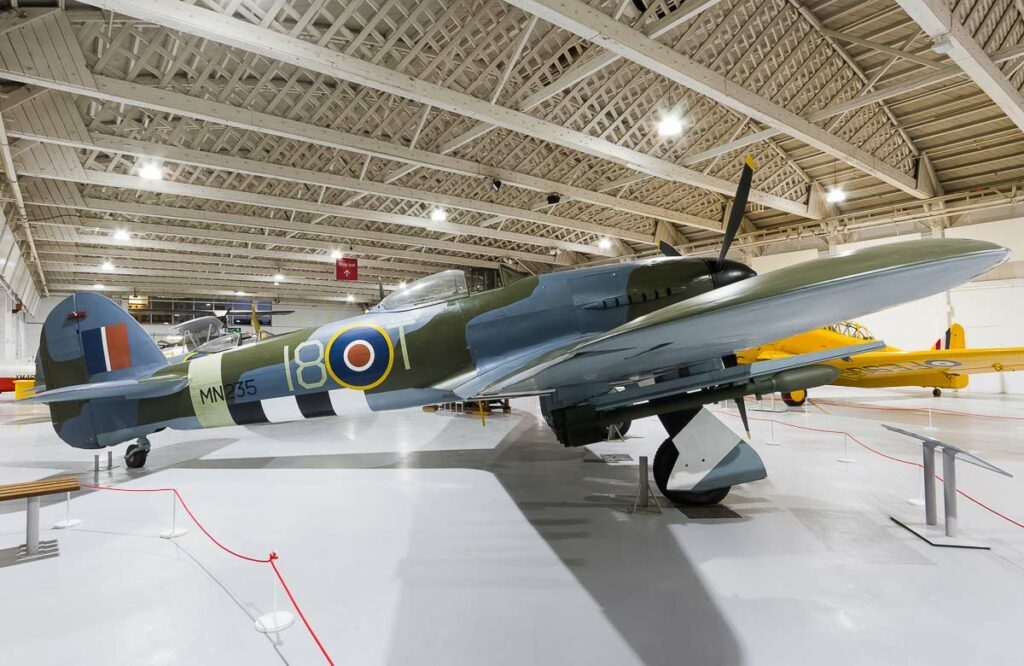The Hawker Typhoon, a WWII British single-seat fighter-bomber, known for its heavy armament and ground-attack capabilities, powered by a Napier Sabre engine.
The Hawker Typhoon emerged as a critical aircraft for the Royal Air Force (RAF) during World War II, particularly in ground-attack roles. Originally designed as a high-altitude interceptor, it evolved into one of the most effective ground-attack aircraft of the war. This article explores the Typhoon’s development, design, capabilities, and combat history.
History of the Development of the Hawker Typhoon
The development of the Hawker Typhoon began in the late 1930s, amidst the rapid evolution of military aviation technology. The RAF sought a new fighter capable of countering emerging threats, particularly at high altitudes. Hawker Aircraft, led by designer Sydney Camm, initiated the Typhoon project to fulfill this need.
The Typhoon was designed to be a successor to the Hawker Hurricane, with a focus on speed and altitude performance. The first prototype flew on February 24, 1940. The aircraft was developed during a critical period in aviation history, where speed, firepower, and versatility were becoming increasingly important.
Its development was marked by the urgent requirement for advanced fighter designs in the face of World War II.
Design of the Hawker Typhoon
The Typhoon’s design was centered around the powerful Napier Sabre engine, a 24-cylinder H-type liquid-cooled engine, which provided exceptional power. The aircraft had a length of 9.73 meters and a wingspan of 12.67 meters. Its airframe was robust, designed to accommodate the large engine and heavy armament.
The design of the Typhoon included a thick wing, which provided room for fuel and armament but limited its high-altitude performance and agility. Despite these drawbacks, the Typhoon’s robust construction made it well-suited for low-altitude operations, particularly ground-attack missions.

Performance of the Hawker Typhoon
The Typhoon’s performance was formidable in its adapted role. It could reach a top speed of about 663 km/h (412 mph) and had a service ceiling of 10,360 meters (34,000 feet). The aircraft’s range was approximately 790 kilometers (490 miles), allowing for effective sorties over the battlefield.
When compared to contemporaries like the German Focke-Wulf Fw 190, the Typhoon was less agile as a dogfighter but superior in ground-attack due to its heavy armament and rugged construction.
Military Use and Combat of the Hawker Typhoon
The Typhoon was heavily armed, typically with four 20mm Hispano cannons and could carry bombs or rockets. Initially plagued with developmental issues, it found its niche in ground-attack roles, particularly following the Normandy landings in 1944. The Typhoon was crucial in targeting German armored vehicles and fortifications.
Its effectiveness was demonstrated in various operations, notably in the Battle of Normandy and the subsequent Allied advance through Europe. The Typhoon faced competition from various German aircraft but excelled in its specialized role of ground-attack.
The Typhoon was primarily used by the RAF and was not widely exported. Post-war, its role was filled by more advanced aircraft, leading to its gradual retirement from service.
The Hawker Typhoon stands as a testament to the adaptability and resilience in military aviation. Its transition from a high-altitude interceptor to a premier ground-attack aircraft illustrates the dynamic nature of aircraft roles during World War II. The Typhoon’s legacy is marked by its significant contribution to the Allied ground campaigns, particularly in the liberation of Europe, and its role in the evolution of fighter-bomber aircraft.
Back to the Bombers section.